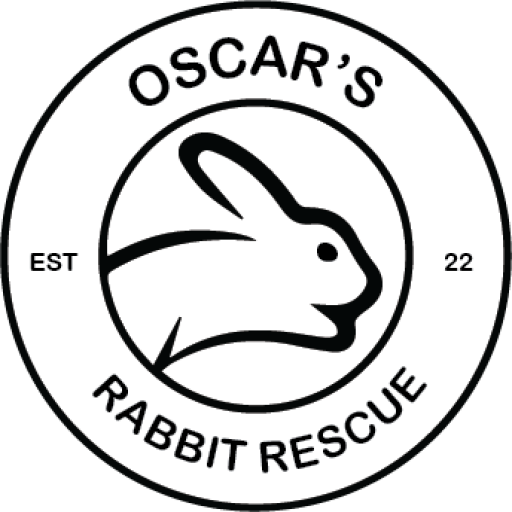Is a Pet Rabbit Right for You?
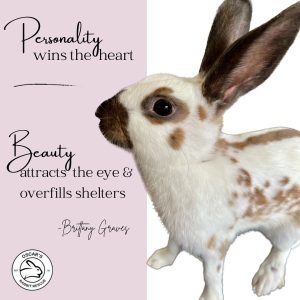 Domestic rabbits make great companion pets much like a dog or a cat. They are intelligent, social pets. Most rabbits will show you as much affection as you give them. It is time the world looks at them like our beloved dogs and cats rather than a caged animal. Small cages do not provide enough room and lead to spine issues because of the inability to hop and stretch. Rabbits kept in small cages become depressed, and the lack of exercise leads to health problems such as obesity and muscle weakness. Instead, exercise pens are recommended with time out of the pen in safe areas indoors to play, explore, and exercise.
Domestic rabbits make great companion pets much like a dog or a cat. They are intelligent, social pets. Most rabbits will show you as much affection as you give them. It is time the world looks at them like our beloved dogs and cats rather than a caged animal. Small cages do not provide enough room and lead to spine issues because of the inability to hop and stretch. Rabbits kept in small cages become depressed, and the lack of exercise leads to health problems such as obesity and muscle weakness. Instead, exercise pens are recommended with time out of the pen in safe areas indoors to play, explore, and exercise.
Your rabbit(s) belongs indoor with you as part of your family. Rabbits are curious, social, and active. They are most active in the morning and evenings which is great for those with active schedules. They need regular social interaction and love to listen and watch to you. Therefore, if using a cage/pen, set this up in an area you are active in like a family room or kitchen. If the area is very active, provide a small “cave” as a safe place to lunge when stressed or tired (e.g., cardboard boxes with a hole cut in it, cardboard cat houses without catnip, etc.).
Outdoor dangers: Loneliness and depression, predators breaking into fences/hutches, insects that carry disease, parasites, temperatures causing heatstroke (over 74° F is dangerous) or frostbite. Now with Rabbit Hemorrhagic Disease (RHDV-2), it is even more important to keep your rabbits indoors at all times to help prevent contracting this contagious and highly deadly disease. Outdoor rabbits often develop undetected health issues.
Other considerations:
- Rabbits are expensive and require rabbit savvy/exotic vets yearly and as needed for injury/illness. All rabbits should be spayed/neutered to prevent high rates of cancer in females, excess odors, and unwanted behaviors (e.g., spraying urine, aggression, etc.). Prepare for emergencies. All rabbits should be vaccinated for RHDV-2 as it is the best way to provide protection against RHDV-2.
- Rabbits are fragile – bones, especially backs and legs, break easily when dropped, and sometimes when they jump wrong.
- Rabbits are not typically snuggly. Although some may tolerate snuggles, most rabbits do not like being picked up or held. They are a prey animal, so when their feet are not on the ground it causes fear. Age can cause changes in this area as personalities and hormones develop.
- Frequent grooming is required (brushing, nail trims, and ear cleaning for lop eared rabbits). Matted hair creates pain. Long nails cause toes to permanently deform and frequently cause broken toes. Lop eared rabbits are prone to ear infections due to being unable to adequately clean their ears on their own.
- Diet, understanding GI stasis, and signs/symptoms of pain are absolutely crucial as many rabbits die every day due to these areas of rabbit care.

Adding a Pet Rabbit to Your Home
Do not get upset if your new rabbit regresses when brought home. Your rabbit needs time and space to get used to the new surroundings and people and can sense your emotions. There are new smells, sounds, and everything around your rabbit has changed.
Remember, rabbits are prey animals so your rabbit is very scared and needs time to learn to trust you. Do not bombard your new rabbit and expect immediate companionship. Provide a space to hide and honor that as your rabbit’s safe space where he/she will not be bothered.
Your rabbit may not use a litter box well in the new surroundings and/or may mark spots. Give your new rabbit time to adjust. Keep picking up the poop to put into the litter box, and put food and hay in/above it to encourage use. Rabbits like to pick spots to pee. Try moving the litter box to that spot. If you have another rabbit in the home, you may continue to see some difficulty with 100% litter box use while not bonded.
If you have another rabbit, absolutely do not try bonding quickly. Bonding takes time and patience. Do NOT attempt to bond rabbits that have not been sterilized. Their hormones will cause problems. They should be 8 weeks post neuter/spay to allow hormones to normalize after sterilization. One big fight can prevent a bond from ever forming. Please reach out to me or to bonding-specific groups for assistance with bonding. When done wrong, it can lead to severe injuries/death and traumatization of your rabbits. They will not forget it.
Review Bonding Information Here
Some rabbits settle in quickly while others can take months or even years.
IT IS NEVER THE RABBIT’S FAULT!
If you see aggression or warning signs, respect your rabbit. There is a reason (medical or situational). We have seen the most fun-loving, goofball turn into a traumatized rabbit. We have also seen extremely aggressive rabbits become loving and snuggle.
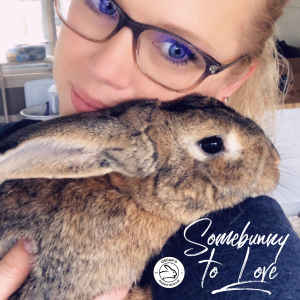
To Do:
1. Understand Rabbit Diet. Many die frequently and quickly from GI Stasis caused by improper diets. This is an absolutely emergent condition after 12 hours of reduced eating/poops as death can happen within 24 – 48 hours. GI stasis information HERE.
2. Set up a Safe Area & Gather Supplies
3. Make an Appointment with a Rabbit-Savvy Vet. This is very important to be done ASAP to establish vet care with you and at least annually. *Rabbits require specialized care.
· GET RHDV-2 VACCINE! This deadly virus has made its way to WI. The only way to protect your rabbit is with the vaccine series.
· Spay/Neuter: Click here
· Understand GI Stasis and pain symptoms which are hidden well: Read more here and here.
· How to Tell if Your Rabbit is Sick: Click here.
4. Prepare an Emergency Kit: Click here
Read! Read! Read! And ask Questions!
Great Resources:
Addtional education topics HERE
Ages & Stages of a Rabbit's Life
Rabbit’s personality, energy levels, and diet needs (see diet section) change as they age.
- Baby Rabbit 2-6 months: This is a timeframe when you see subtle signs of your bunny’s true nature, but will never truly know what the bunny’s personality will be as an adult. Bunnies enter their “teenage years” where there can be changes in their behavior. As they reach sexual maturity, friendly, happy bunnies may get territorial and frustrated. Some rabbits, especially females may display aggressive behaviors. They may be hyperactive and curious, finding ways to get in trouble all the time. Over time, the behaviors will calm down with age.
- Young Rabbit 6-8 months: Rabbits get used to life and begin to settle into their personality. If they have already been spayed/neutered and are provided with a safe, healthy environment, young rabbits will be happy and energetic bunnies. They will likely try to test boundaries to see how far they can go while exploring new areas. They will likely have a lot of energy, and it is unlikely that they will settle down for long periods of time to be pet. They likely will not like to be held during this stage.
- Adult Rabbit 18 months – 7 years: Your rabbit will calm down a little and settle into their own personality. This is when a rabbit settles down to be part of the family and may trust you more. Adult rabbits will spend time with you more and enjoy being pet for longer periods of time. They will still be very active and require a lot of exercise and toys to play with. They will likely still have chewing and digging habits, but they might not be quite as persistent as they were before.
- Elderly Rabbit 7-10+ years: A rabbit’s average life expectancy is 10-12 years. They may start to be considered elderly at 6-8 years old. However, some larger size rabbits may have shorter life spans making them elderly anywhere from 4-10 years old. Every rabbit slows at their own pace, but in this stage he/she will start slowing down. The rabbit will lose energy as he/she ages and sleep more often. Fur will start to thin and there will eventually be loss of muscle mass which results in difficulty in zooming around and climbing. Some will lose weight while others may gain weight from being less active.
Sources:
1. “5 Life Stages of Pet Rabbits and How to Keep Them Healthy.” The Bunny Lady, https://bunnylady.com/rabbit-life-stages/.
2. “Baby Rabbits (Domestic).” WabbitWiki, February 9, 2019, http://wabbitwiki.com/wiki/Baby_rabbits_(domestic).
3. “Do rabbits really get womb cancer?” Goddard Veterinary Group, www.goddardvetgroup.co.uk/do-rabbits-really-get-womb-cancer.
4. Harriman, Marinell. “Age Related Behavior.” House Rabbit Society, https://rabbit.org/journal/3-3/age-related-behavior.html.
5. Koi, Sandi. “Domestic Baby Bunnies and Their Mom.” House Rabbit Society, https://rabbit.org/care/babies.html.
Supplies
This is a list of recommended supplies for a happy rabbit. See some of our favorites at the bottom of this page.
- Exercise pen *Nothing with a wire bottom
- Potty-box *no grates
- Water bowl
- Food bowl and/or enrichment activities for foraging for food (e.g., puzzles and dig mats)
- Supply of hay
- Supply of high-qaulity food pellets (no seeds/colored additives)
- Vegetables (see below for safe veggies)
- Supply of potty pellets
- Assorted toys
- Hidey tunnel
- Animal carrier
- Nail trimmer & brushes
- Emergency Kit (see here)
Housing & Exercise
Many house rabbit owners use an exercise pen for safety when their rabbit is home alone. Minimally, the rabbit should be able to stretch out, stand upright without touching the top, and hop at least 5 times without touching the wall.
We recommend exercise pens (X-pens) at least 30” tall (example here). Provide a non-slip, solid bottom. Crates cause injuries to the feet and toes.
Rabbits are most active in the morning and evening and sleep during the day and at night. Provide 3-6 hours of exercise, stretch, and playtime daily outside their cage.
*Never let your rabbit go outdoors due to many dangers (predators, parasites, RHDV-2, etc.).*
HOUSEHOLD HAZARDS described in detail here.
Temperatures
Rabbit Diet
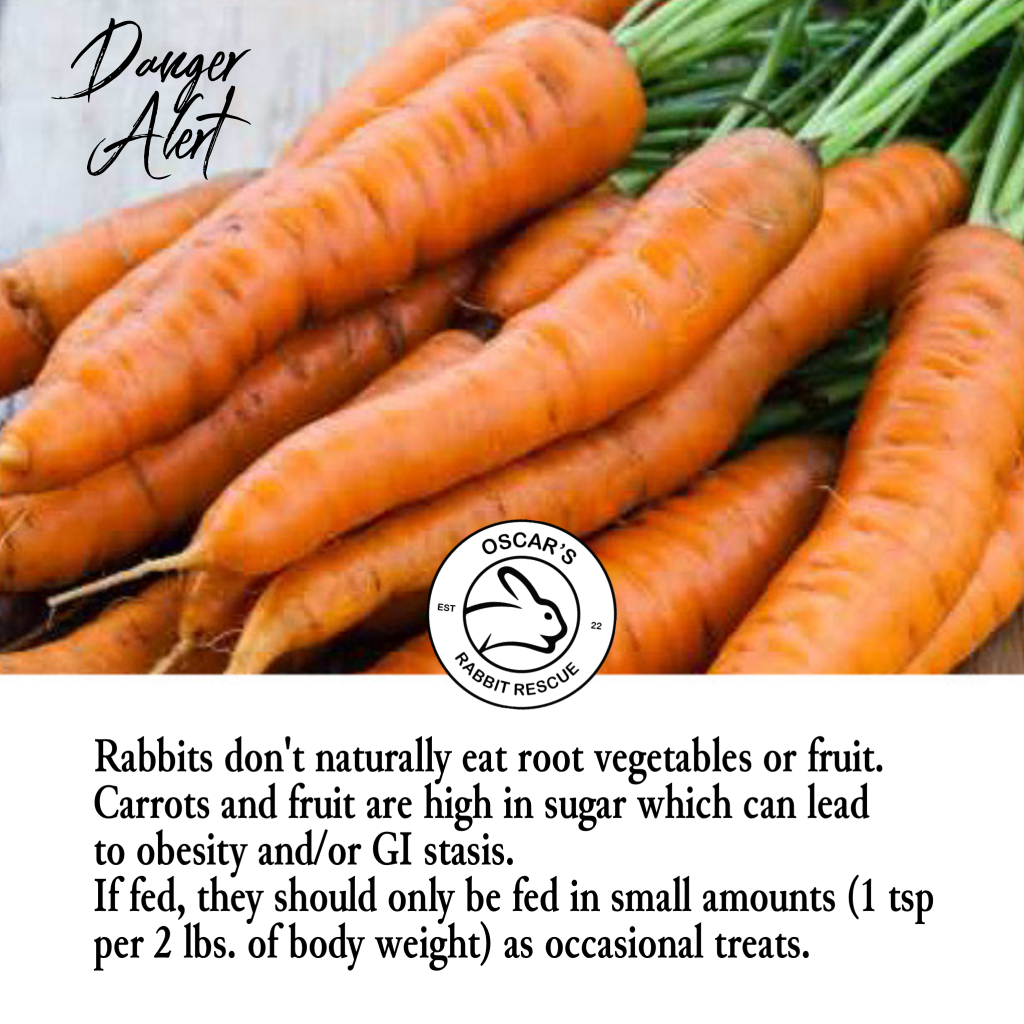
Very important! Many rabbits die regularly due to GI stasis, a quickly fatal condition, frequently caused by improper diets.
Absolutely NO chocolate (poisonous!), corn, seeds cookies, crackers, breakfast cereals, bread, pasta, yogurt drops or other “human treats.”
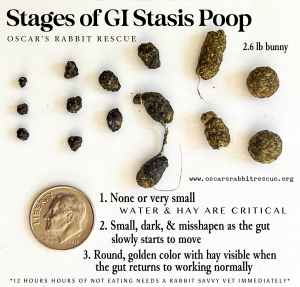
See More about GI Stasis HERE.
Emergency Kit: HERE.
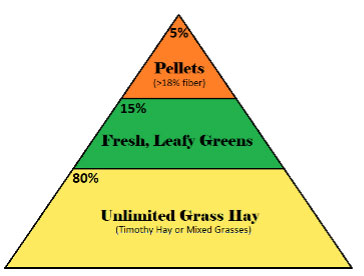 Hay
Hay
Grass hay makes up 80% of a rabbit’s diet and must be available in unlimited quantities at all times. Hay is essential to good health. Hay stimulates the rabbit’s GI tract to work correctly and helps prevent blockages in the GI tract and dental issues by keeping teeth trimmed. Grass hay is rich in Vitamin A and D, calcium, protein, and other nutrients.
IMPORTANT: Before introducing any fresh foods, it is best if your rabbit has been eating grass hay for a minimum of 2 weeks. The grass hay will help to get your rabbit’s GI tract motility and flora in good working order so that he/she will be able to accept new foods more easily.
Provide a variety of fresh, grass hay twice daily as it provides natural foraging to find the best pieces. Your rabbit will dig through the hay to find the best pieces to eat; therefore, never consider what they don’t want to eat “wasted hay.” Varying the type of grass hay or mixing hays is a great idea (e.g., timothy, orchard, oat hay, brome, etc.). Alfalfa is not grass, but rather a legume (in the pea and bean family) and is only safe for rabbits under 6 months of age.
Store hay in dry, temperature-controlled climates out of plastic to prevent mold.
Water
Fresh water must be supplied daily. Please make sure water is always available in a heavy crock/bowl (NO bottles) to encourage drinking. Rabbits need a lot of water every day, and bottles do not allow them to drink as much as they need. Water is necessary to flush excess calcium from the kidneys and bladder, and it is essential for healthy function of the gut and its bacteria.
Pellets
Pellets should be fresh and should be high in fiber (>18%), and low in protein (<14%), calcium (<0.9%) and fat (<2%). Pellets should make up less of a rabbit’s diet as he or she grows older; amounts are based on weight and age. Alfalfa pellets are fine for younger rabbits, but timothy pellets are preferred for older rabbits to prevent kidney stones from too much calcium.
Pellets should NEVER have colored pieces or seeds in them. Always check the ingredients. Many companies sell “adult pellets” that are not timothy based and have poor ingredients in them.
Vegetables
Feed 1 cup of fresh, washed leafy green vegetables for each 2-4 lbs. of body weight. Select at least three types of vegetables daily to offer variety. Fresh vegetables provide nutrients and moisture in the diet, which is good for kidney and bladder function.
IMPORTANT: When introducing new fresh foods to any rabbit’s diet, it is best to go slowly to allow the GI tract and all its important microorganisms time to adjust. Introduce one new food every three days and keep a watch on the stools. Eliminate from the diet if it causes soft stools or diarrhea.
Iceberg lettuce is mostly water and can cause diarrhea; carrots are sugar-rich and may cause intestinal problems in some rabbits. Brassicas (Brussels sprouts, broccoli, cauliflower, cabbage, kohlrabi, mustard greens) may cause gas and soft, smelly poops. Provide them in limited amounts.
Leafy Green Vegetables for Rabbits (75% of fresh portion of your rabbit’s diet)
- Arugula
- Basil (any variety)
- Beet greens (tops)
- Bok choy
- Borage leaves
- Carrot tops
- Chicory
- Celery
- Cilantro
- Clover
- Collard greens
- Cucumber leaves
- Dandelion greens (no pesticides)
- Dill leaves
- Endive
- Escarole
- Fennel (leafy tops & base)
- Green lettuce (not Iceberg)
- *Kale
- Mache
- Mint (any variety)
- Peppermint leaves
- Radicchio
- Raspberry leaves
- Red lettuce
- Romaine lettuce
- Spring greens
- Turnip greens
- Watercress
- Wheatgrass
- Yu Choy
*There is current dispute in the scientific community regarding the levels of oxalates and goitrogens in kale. Some feed it daily without issues while others have found that kale fed in large amounts on a daily basis may contribute to bladder sludge and other health issues.
Rotate Weekly Due to Higher Oxalic Acid Content (1 out of 3 varieties of greens a day)
- Beet greens
- Mustard greens
- Parsley
- Radish tops
- Spinach
- Swiss chard
Sprouts (from 1 to 6 days after sprouting, sprouts have higher levels of alkaloids)
Safe in Moderation (About 1 tablespoon per 2 lbs of body weight a few times per week, not daily)
- Bell peppers
- Broccoli (leaves & stems)
- Carrots (high in sugar)
- Cabbage (any type)
- Celery (cut into small pieces)
- Cucumber
- Pea pods (the flat edible kind)
- Summer squash
- Zucchini
- Edible flowers (chamomile, dandelion, hibiscus, nasturtiums, pansies, rosehips, violets without seeds)
***Grown without chemical sprays/pesticides or bought dried from a reliable vendor***
Fruit
Limit fruits to 1 teaspoon per 2 lbs. of body weight a few times a week, not daily (or 1-2 tablespoons per 5 lbs. of body weight a few times a week) from the list below of high fiber fruits. Cut out fruit if dieting.
Sugary fruits such as bananas and grapes should be used only sparingly, as occasional treats. Bunnies love sweets and will devour them, so be careful. Too much sugar slows the GI tract and leads to GI stasis.
*Remove pits and seeds*
- Apple (without stem & seeds)
- Apricot
- Banana
- (remove peel; no more than about 2 1/8 inch slices a day for a 5 lb rabbit…they LOVE this!)
- Berries (any type)
- Cherries (without pits)
- Kiwi
- Mango
- Melons
- Orange (including peel)
- Papaya
- Peach/Nectarine
- Pear
- Pineapple (remove skin)
- Plum (without pit)
- Star Fruit
Treats (Optional)
Many pet stores sell treats disguised as “healthy” choices; most of these are fat- and sugar-rich and are not healthy at all. Any treat that lists flour or sugar as a main ingredient or corn in it is a NO. The best treats are inexpensive, unprocessed ones: A small apple slice, a slice of banana, 2-3 raisins, a dried and unsweetened cherry or strawberry, a pinch of whole oats, a dish of cooled herbal tea, a small piece of carrot, or spoonful of fresh apple cider. Treats are a fun way to bond with your rabbit, a good way to monitor appetite, and serve as a nice reward when medicine has to be given.
!!! Dangerous / Toxic !!!
- Avocado
- Bread
- Corn
- Dairy Products
- Eggplant
- Flour
- Fruit pits & some seeds
- Garlic
- Iceberg lettuce
- Meat
- Mushrooms
- Nuts
- Onions
- Pasta
- Rhubarb
- Potatoes
- Processed foods (e.g., chips, cookies)
- Seeds
- Sugar (other than small amounts in the safe, moderation list above)
Other: Many plants and flowers. Some are safe, but not all.
Vitamins, Salt or Mineral Block, Rabbit Supplements and “Enhancers”
These are unnecessary if the rabbit is receiving a balanced diet of hay, green-leafy vegetables, and a good quality pellet food fed in limited amounts.
Diet Broken Down By Age:
Alfalfa based pellets we love by Oxbow: Young Rabbit Food or Garden Select Young Rabbit Food
WHAT QUANTITIES OF FOOD SHOULD I FEED BABIES AND “TEENAGERS”?
- 3 to 4 weeks–mother’s milk, nibbles of alfalfa and pellets
- 4 to 7 weeks–mother’s milk, access to alfalfa and pellets
- 7 weeks to 6 months–unlimited alfalfa based pellets, unlimited hay
- 12 weeks–introduce vegetables (one at a time, quantities under 1/2 oz.)
WHAT QUANTITIES OF FOOD SHOULD I FEED YOUNG ADULTS? (6 MONTHS TO 1 YEAR)
- Introduce timothy hay, grass hay, oat hay, and other hays; decrease alfalfa
- Switch to timothy based pellets and decrease pellets to 1/2 cup per 6 lbs. body weight
- increase daily vegetables gradually; make sure your rabbit can tolerate
- fruit daily ration no more than 1 oz. to 2 oz. per 6 lbs. body weight (because of calories)
WHAT QUANTITIES OF FOOD SHOULD I FEED MATURE ADULTS? (1 TO 5 YEARS)
- Unlimited timothy, grass hay, oat hay
- 1/4 to 1/2 cup timothy based pellets per 6 lbs. body weight (depending on metabolism and/or proportionate to veggies)
- Minimum 2 cups chopped vegetables per 6 lbs. body weight; always introduce vegetables and greens slowly to make sure your rabbit can tolerate
- fruit daily ration no more than 2 oz. (2 Tbs) per 6 lbs. body weight.
WHAT QUANTITIES OF FOOD SHOULD I FEED SENIOR RABBITS? (OVER 6 YEARS)
- If sufficient weight is maintained, continue adult diet
- Frail, older rabbits may need unrestricted pellets to keep weight up. Alfalfa can be given to underweight rabbits, only if calcium levels are normal. Annual blood workups are highly recommended for geriatric rabbits.
Enrichment
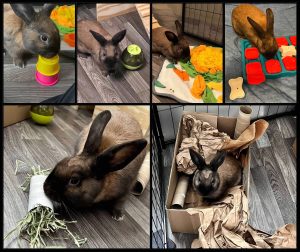 Rabbits love to chew and dig. Please provide various safe toys and a hidey house or tunnel to keep your bun from getting bored. A bored rabbit becomes destructive! Rabbits love to play with cardboard boxes. Please remove tape. You can give empty toilet paper/paper towel rolls as toys. Rabbits also like to play with baby toys, cars and trucks, Legos, and anything they can toss around.
Rabbits love to chew and dig. Please provide various safe toys and a hidey house or tunnel to keep your bun from getting bored. A bored rabbit becomes destructive! Rabbits love to play with cardboard boxes. Please remove tape. You can give empty toilet paper/paper towel rolls as toys. Rabbits also like to play with baby toys, cars and trucks, Legos, and anything they can toss around.
Dig boxes, treat dispensers for pellets, and puzzles make great enrichment activities.
Please make sure to remove any toy your rabbit may take bites out of. Swallowing plastic will be a medical emergency.
It’s important to frequently challenge your pet’s natural range of motion to keep arthritis and age-related muscle wasting at bay. Reaching above their heads (either by standing on hind legs or extending their neck). Hang daily vegetable rations at various heights throughout your rabbit’s living space to encourage full extension of their spine as they reach up for their goodies.
See more ideas HERE
Nail Trimming
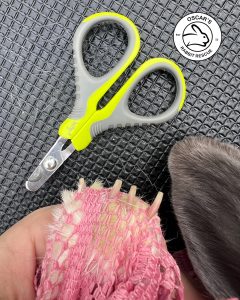 Toe injuries are the most common injury we see on rabbits that we take into our rescue. Untrimmed toenails are the the leading cause of toe injuries. Grates used in cages and litter boxes also commonly cause injuries. Long nails can also cause permanently deformity to toes.
Toe injuries are the most common injury we see on rabbits that we take into our rescue. Untrimmed toenails are the the leading cause of toe injuries. Grates used in cages and litter boxes also commonly cause injuries. Long nails can also cause permanently deformity to toes.
Nail Trimming Tips
1. Safely secure your rabbit to avoid injury. If your bun fights, wrap him/her in a towel to help prevent injury from jumping, dropping, or kicking.
2. Use lace to easily see the nails.
3. Use light pressure with the scissors and if they flinch don’t clip there.
Trim nails every 4-6 weeks to help prevent discomfort and broken toes.
Brushing
Carefully brush your rabbit every couple weeks, more often during molting (moulting). If your rabbit’s poop is connected together forming a kind of rosary, it means they are ingesting hair and you must be more vigilant at brushing.
Molting is natural. It is when the rabbit’s fur is shed and replaced with new fur. In adult rabbits it typically happens in Spring and Fall. Some breeds molt more noticeably than others, and you may notice some smaller molting at other times of the year. Rabbits under 1 year old will molt around 5-6 weeks old and again around 4-5 months old. More about molting HERE.
Brushing helps prevent ingestion of hair that can cause blockages in the GI tract. It also helps with comfort for the rabbit. You can also gently and easily pull out hair that is loose and ready to come out.
Hair mats cause pain by pulling on the skin. This also restricts the rabbit’s ability to move.
Rabbits with long hair will need to be brushed more frequently.
Exception: Angora wool grooming should be done with a blowing technique rather than regular combing. Combs can cause breakage in the wool that can lead to more matting of the fur. This can be done with a gentle vacuum or a hair dryer (avoid overheating the rabbit).
Ear Cleaning
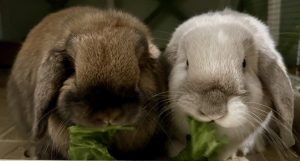
Ear infections in rabbits are hard to treat and can quickly become fatal as infection spreads.
Immediately consult a vet if you notice behavior changes, pain symptoms, decreased eating or pooping, head tilt, flickering eyes, or other concerns.
Causes:
Lop eared rabbits are at high risk because they cannot clean their own ears well and ear canal shapes/sizes. Lops have droopy ears, smaller ear canals, and an L-shaped ear canal that can prevent detection of ear infections by just looking into the ears with an otoscope. Ear infections typically become chronic, and typically need recurrent antibiotic therapy. Many lop rabbits go on to have this a very expensive, invasive procedure called a partial ear canal ablation – bulla osteotomy or PECA-BO.
Other causes: Poor environment, long nails, genetics, etc.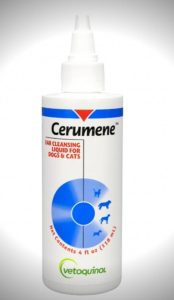
Prevention
1. Routine vet care and exams.
2. Clean lop eared rabbit ears every 1-2 weeks (frequency & other breed needs can vary based on each rabbit’s needs).
3. Maintain a clean environment.
4. Trim nails regularly.
How to Clean Ears:
- Pour a small amount of solution in the ear.
Vet recommended solutions to help dissolve wax: 1) Cerumene, 2) EpiKlean. - Massage the base of the ear.
- Do not stick anything into the ear, but you may gently wipe with a cotton ball if needed.
Ear infections must be detected and treated early. Failure to treat leads to severe pain and death because the infection spreads.
More Grooming Topics HERE
Some Items We Love:
*Avoid Kaytee brand because they market many unsafe products for Rabbits*
Always monitor to avoid ingestion.
- House: Xpen (at least 36” tall for most). *No grates
- Non-slip flooring to prevent injuries – padded is great for feet to help prevent sore hocks. Examples: Fleece, quilts, waterproof mats
*Monitor it is not being eaten/ingested - Hide cords, cover outlets, and bunny proof your home for safe free roaming and exercise time (at least a few hours a day).
Examples of cord protectors or strips. - Litter Box (no grates) that Your Bun Fits Well in With Space to Move Comfortably In. Under-bed storage containers work great as litter boxes as well. More info. here.
- Litter: We love natural pine pellets which can be found in a horse section of a Fleet Farm/Tractor Supply Plus store at around $7 for 40 lbs.. We have found this reduces odor most and is cost effective. More info. here.
- Heavy Bowl/Crock for water (NO bottles) because rabbits drink a lot of water.
- Quality Pellets, such as Oxbow *avoid anything with seeds/colored pieces/additives and read ingredients*
Examples & details based on age and size here. - Quality Timothy hay and a plan to store out of plastic and inside to prevent mold. Hay is essential for proper health and prevention of dental issues and will make up 80% of your rabbit’s diet. (Example: Oxbow). Details & Other Examples here.
- Brushes that are safe for delicate skin. Your rabbit will molt! Regular brushing is needed to prevent a blockage from too much ingestion of hair. Examples: Buster Comb and Small Comb *plastic tips*
- Nail Clipper
- Hidey hut/Tunnels to feel safe in (boxes work great!). We also love cardboard cat houses (no catnip).
- Enrichment Activities/Toys to provide Stimulation & Exercise. Rabbits naturally like to dig and forage! We love to feed daily pellet rations in toys/dig boxes.
- Pellet Dispensers or Balls for daily pellet ration
- Cardboard Scratchers / Houses *No catnip. Cardboard without much dye or tape with holes cut out work well, too.
- Natural/Safe Balls to Chew
- Puzzles
- Timothy Hay Mats
- Edible Tunnel
- Non-edible Tunnels
- Foraging Mats
- Stacking Cups
- Toy Keys
- Ear cleaner for lop-eared rabbits
- Emergency Kit
Education/Resources:
- ~Bringing Home a Pet Rabbit~
- ***Diet for a Domestic Rabbit
- Activities
- Ages & Stages of Life
- Baby Bunnies
- Bonding Rabbits
- Emergency Preparedness
- Ear Cleaning
- Enrichment Activities
- GI Stasis in Rabbits
- Grooming & Nail Trimming
- Household Hazards
- Litter & Litter Boxes
- RHDV-2
- Spay & Neuter
- Supplies
- Vets for Your Rabbit
- Wild Bunnies
- Bearded Dragons
- Guinea Pig Guide
- Blog
